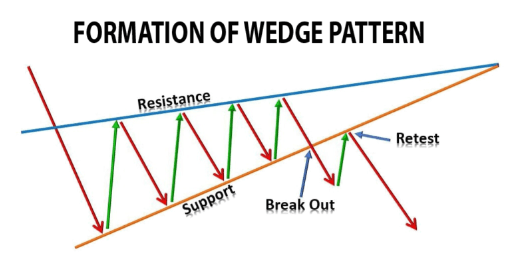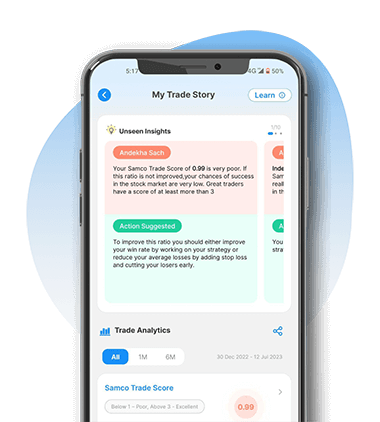In this article, we will discuss
- What is the Wedge Pattern?
- Types of Wedge Patterns in the Stock Market
- Pros and Cons of Wedge Pattern Strategy
- Wedge Pattern in the Indian Trading Market
- Final Words
- FAQs
Chart patterns in the stock market play a crucial role for investors and traders in understanding how a stock is performing. Such patterns provide insight into the potential movement of prices and offer guidance to traders on how to proceed. One such pattern that is significant in the financial market to understand for every trader is the Wedge Pattern.
Keep reading this article to know everything about wedge pattern trading strategy and how to use it to identify price trends.
What is the Wedge Pattern?
A wedge trading pattern is a formation noticed at the bottom or top of a price trend chart distinguished by two converging straight lines. Two lines are drawn connecting the low and high swings of stock prices. This shows a pattern of rising or falling prices forming a narrower price range.
Source: https://www.spidersoftwareindia.com/blog/understanding-the-wedge-pattern-a-technical-analysis-guide/
To understand the wedge pattern, you must know that the pattern differs from a typical triangle. This is because both the boundary lines tend to slope down or up.
Drawing the two trend lines that converge in the form of a triangle shape helps to create this pattern. Make sure to know that this pattern is based on different time frames, such as daily, monthly or weekly movement of price.
Investors and traders generally utilise this strategy to identify potential signs of trend reversals and make trading decisions based on breakout patterns.
Types of Wedge Patterns in the Stock Market
There are mainly two types of wedge pattern trading that are followed in the market. They are discussed in detail below.
Rising Wedge Pattern
A rising wedge pattern is a chart pattern that indicates a bearish trend in the market. The pattern is formed by rising prices over a certain period and indicates an upcoming bearish reversal. Traders tend to use options or shorting to make bearish trades if they see this pattern.
In most cases, traders use a bearish wedge pattern to identify any reversals in trends and make significant trading decisions that are based on the breakout direction of the pattern. Also, a downward pattern tends to signal a potential drop in the price of stock and securities.
Falling Wedge Pattern
A falling wedge pattern indicates a bullish market trend. In this case, two converging lines of trend form a falling wedge pattern and the price of a stock falls for a specific period. You must understand that having an upward breakout from a wedge trading pattern signals a possible rise in the stock price.
Traders use this bullish wedge pattern to identify any reversals of the trend and use that information to make trading decisions. The decision is made as per the breakout direction of a pattern. This wedge pattern is a key tool for traders due to its reliability in forecasting price trends.
Pros and Cons of Wedge Pattern Strategy
While you are understanding the wedge pattern strategy, you need to have an idea about its benefits and limitations within the stock market. Given below are the pros and cons of the wedge pattern.
Pros:
- This pattern reveals reversal points reliably
- Identification is done for various time frames.
- It can be used in conjunction with other technical indicators for confirmation.
Cons:
- It can be hard to determine the overall direction of a trend.
- The pattern does not work all the time and must not be the sole consideration for trading decisions.
- Having a proper exit strategy is important for maximising profit and limiting any losses.
Wedge Pattern in the Indian Trading Market
An appropriate wedge trading pattern within the stock market needs to follow a systematic approach, for which you need to consider the following factors.
- Estimation of the price target is necessary to measure the height of a wedge trading pattern and project the same in the breakout direction.
- For rising wedge chart patterns, consideration for short positions is necessary during price breaks below the lower trendline.
- Implementation of stop-loss orders is necessary to manage potential market risks. You need to place them beyond the opposite wedge pattern for protection from any false breakouts.
- Pay attention towards trading volume at the time the price breaks out of the wedge pattern.
- For falling wedge chart patterns, consideration of longer positions, when the price break is above the upper trendline, is necessary and significant.
Conclusion
Overall, the wedge pattern is a useful tool for traders in the stock market. Using it, traders can easily recognise stock and price patterns, understand their formation and incorporate them with other technical analysis indicators.
If you want to have a look at the wedge pattern of a stock, use the "New Gen" SAMCO app. It will give you all the necessary details and help you make informed financial decisions.
Frequently Asked Questions
Q1. What is the best timeframe to implement a wedge trading strategy?
Ans. A wedge pattern is formed during any time frame. Nonetheless, while considering it as a technical method of analysis, a higher time frame gives a reliable pattern. Overall, a daily and higher time frame is best to implement this strategy.
Q2. What mistakes should you avoid during wedge trading?
Ans. Some mistakes to avoid for wedge pattern trading are lacking an appropriate strategy to manage risks, not considering the entire market trend, not booking profits at the target and lacking an exit plan.
Q3. Are there any risk management strategies to apply for a wedge pattern?
Ans. There are quite a few risk management strategies you can apply for wedge pattern trading. This includes using stop-loss orders to limit catastrophic losses, utilising position sizing to limit capital risk, and diversifying trades across different time frames.
Disclaimer: INVESTMENT IN SECURITIES MARKET ARE SUBJECT TO MARKET RISKS, READ ALL THE RELATED DOCUMENTS CAREFULLY BEFORE INVESTING. The asset classes and securities quoted in the film are exemplary and are not recommendatory. SAMCO Securities Limited (Formerly known as Samruddhi Stock Brokers Limited): BSE: 935 | NSE: 12135 | MSEI- 31600 | SEBI Reg. No.: INZ000002535 | AMFI Reg. No. 120121 | Depository Participant: CDSL: IN-DP-CDSL-443-2008 CIN No.: U67120MH2004PLC146183 | SAMCO Commodities Limited (Formerly known as Samruddhi Tradecom India Limited) | MCX- 55190 | SEBI Reg. No.: INZ000013932 Registered Address: Samco Securities Limited, 1004 - A, 10th Floor, Naman Midtown - A Wing, Senapati Bapat Marg, Prabhadevi, Mumbai - 400 013, Maharashtra, India. For any complaints Email - grievances@samco.in Research Analysts -SEBI Reg.No.-INHO0O0005847







Leave A Comment?